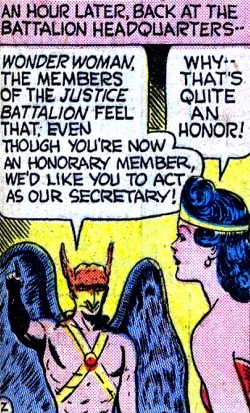This past holiday weekend, your Blog-Manager Fairy Princess was in Savannah, as part of the World History Association annual conference. It was a terrific–if unnecessarily humid–trip, full of fascinating talks and interesting conversations, and lots and lots of book recommendations. There were a number of fascinating talks given about using alternative texts and materials in the classroom; my favorite was on the use of comic books as history text.
As literacy tools, comics are invaluable. They engage both the linguistic and the visual aspects of the brain, making connections between the two in ways that traditional texts and textbooks don’t. But they can also teach about aspects of culture that textbooks can’t, or won’t. One of the best examples of this, is the iconic heroine Wonder Woman.
Wonder Woman, made her debut in DC Comics in January 1942. She was the brain-child of psychologist William Marston (who, incidentally, invented the modern polygraph machine). Marston believed that women were more inherently honest than men, and generally more capable in stressful or dangerous situations. His goal in creating Diana Prince (aka Wonder Woman), was to present a heroine who was strong, confident, and successful as both a superhero and as a professional in a male dominated world. Under Marston’s guidance, Wonder Woman not only defended America from Nazis, evil monopolies, and corporate inequality, she also taught young people–young women especially–to stand up for themselves and believe in their own strength.
Marston, like his heroine, had to battle to convince DC Comics of Wonder Woman’s viability, despite high readership among both boys and girls. When DC formed the Justice League of America under Gardner Fox, Wonder Woman was made an honorary member…and the group secretary, who kept notes while the men went off to save the world. When Marston realized what was going on, he wrested back control of his character, and proceeded to write comics about what Wonder Woman actually did while acting as secretary–turns out she wasn’t behind the desk most of the time!
Following Marston’s death in 1947, the Wonder Woman franchise passed into the hands of Robert Kanigher, who began transforming Wonder Woman into the more sexualized, less assertive figure that we think of today. But it’s clear that studying the origins of Wonder Woman can help us tell a different story about contemporary social and gender issues in America than traditional textbooks permit.
This led to a discussion about another pop heroine of the same era–Nancy Drew. Nancy Drew was the brain child of Edward Stratemeyer, who created the Hardy Boys Series in 1926. The series was so popular that Stratemeyer decided to extend the franchise to girls–even though he believed a woman’s place was in the home. However, the series’ first primary author, Midred Benson, created a woman far different from Stratemeyer’s original idea.

The original Nancy Drew was sassy and feisty; she carried a gun, knew how to protect herself, and she did it well. Like Wonder Woman in many ways, Nancy lived in a kind of utopia where the Depression didn’t hurt, where war was far away, and where you could always have clean clothes and dinner. But she also provided a model for young girls that was wildly different from the woman she became. By the 1950’s, Nancy had a boyfriend to whom she deferred regularly, and learned to hold her tongue rather than speak her mind. Though the books were shortened in order make writing and reading a faster process, they also omitted a great deal of the power that Nancy originally had.
Learning about these heroines and their history was fascinating, and I love the idea that kids get to read these texts in their classroom. That discussion has led me through our catalog to learn more about them both, so I thought I would share my findings with you!
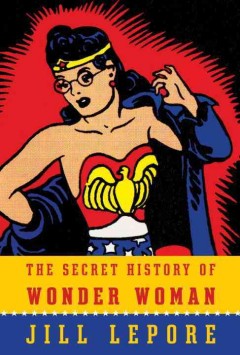 The Secret History of Wonder Woman: Jill Lepore’s book has been hailed as a landmark in pop culture history, and in the history of comic books as a genre. She details, in wonderfully accessible prose, the early years of Wonder Woman, as well as her emphatically unique creator, William Marston. Prominent in this story is Marston’s wives….yes, both of them. Though he was only legally married to Elizabeth, they both welcomed Olive Byrne into their home, and Elizabeth and Olive remained together after Marston’s death. These two women were critical to the creation of Wonder Woman (and Marston’s other inventions), and Lepore gives them their due in her fascinating work.
The Secret History of Wonder Woman: Jill Lepore’s book has been hailed as a landmark in pop culture history, and in the history of comic books as a genre. She details, in wonderfully accessible prose, the early years of Wonder Woman, as well as her emphatically unique creator, William Marston. Prominent in this story is Marston’s wives….yes, both of them. Though he was only legally married to Elizabeth, they both welcomed Olive Byrne into their home, and Elizabeth and Olive remained together after Marston’s death. These two women were critical to the creation of Wonder Woman (and Marston’s other inventions), and Lepore gives them their due in her fascinating work.
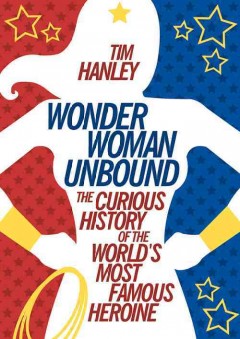 Wonder Woman unbound : the curious history of the world’s most famous heroine: Tim Hanley’s book covers the same time period as Lepore’s book, though in less depth, but also looks at her evolution over the course of the twentieth century, and the ways in which she challenged and conformed to expectations of the day. He also confronts some of Marston’s atypical themes of bondage that appear throughout the Wonder Woman comics; she is repeatedly tied up, chained up, or laced into a straightjacket, but escapes them all (and teaches other women how to break the bonds that hold them) because those who are keeping them captive are not worthy. It’s an interesting theme that is far more complex than many authors have considered–up until now.
Wonder Woman unbound : the curious history of the world’s most famous heroine: Tim Hanley’s book covers the same time period as Lepore’s book, though in less depth, but also looks at her evolution over the course of the twentieth century, and the ways in which she challenged and conformed to expectations of the day. He also confronts some of Marston’s atypical themes of bondage that appear throughout the Wonder Woman comics; she is repeatedly tied up, chained up, or laced into a straightjacket, but escapes them all (and teaches other women how to break the bonds that hold them) because those who are keeping them captive are not worthy. It’s an interesting theme that is far more complex than many authors have considered–up until now.
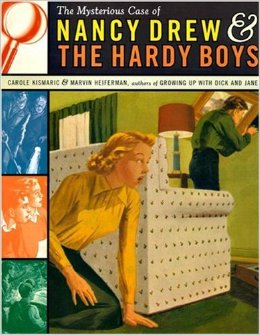 The mysterious case of Nancy Drew & the Hardy boys: Authors Carole Kismaric & Marvin Heiferman trace not only the origins of Nancy Drew and the Hardy Boys, but also consider their creators and authors, uncovering a story about social issues, feminism, and capitalism in America. They talk about the feuds inside Grosset and Dunlap over Nancy’s temper, the treatment of racial minorities in the books, and the need to keep up with growing readers who were increasingly fascinated by television. This is a book that will make you rethink what you know about quintessential American literature, but also the publishing market and commercialism in general. And that cover is just too good for words.
The mysterious case of Nancy Drew & the Hardy boys: Authors Carole Kismaric & Marvin Heiferman trace not only the origins of Nancy Drew and the Hardy Boys, but also consider their creators and authors, uncovering a story about social issues, feminism, and capitalism in America. They talk about the feuds inside Grosset and Dunlap over Nancy’s temper, the treatment of racial minorities in the books, and the need to keep up with growing readers who were increasingly fascinated by television. This is a book that will make you rethink what you know about quintessential American literature, but also the publishing market and commercialism in general. And that cover is just too good for words.
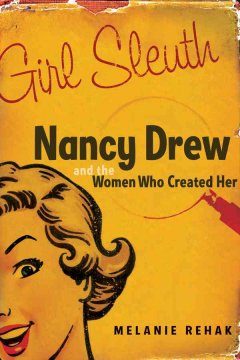 Girl sleuth : Nancy Drew and the women who created her Melanie Rehak discusses the origins of Nancy Drew, with a focus on the two women who were responsible for her: Mildren Benson, and Stratemeyer’s daughter, Harriet, who took over the franchise when he died. What emerges is a story about one fictional character, and how the expectations of generations were tied up in her adventures. This is a fun, perceptive read that makes each contributor to the Nancy Drew cannon a fully-realized character in their own right.
Girl sleuth : Nancy Drew and the women who created her Melanie Rehak discusses the origins of Nancy Drew, with a focus on the two women who were responsible for her: Mildren Benson, and Stratemeyer’s daughter, Harriet, who took over the franchise when he died. What emerges is a story about one fictional character, and how the expectations of generations were tied up in her adventures. This is a fun, perceptive read that makes each contributor to the Nancy Drew cannon a fully-realized character in their own right.



